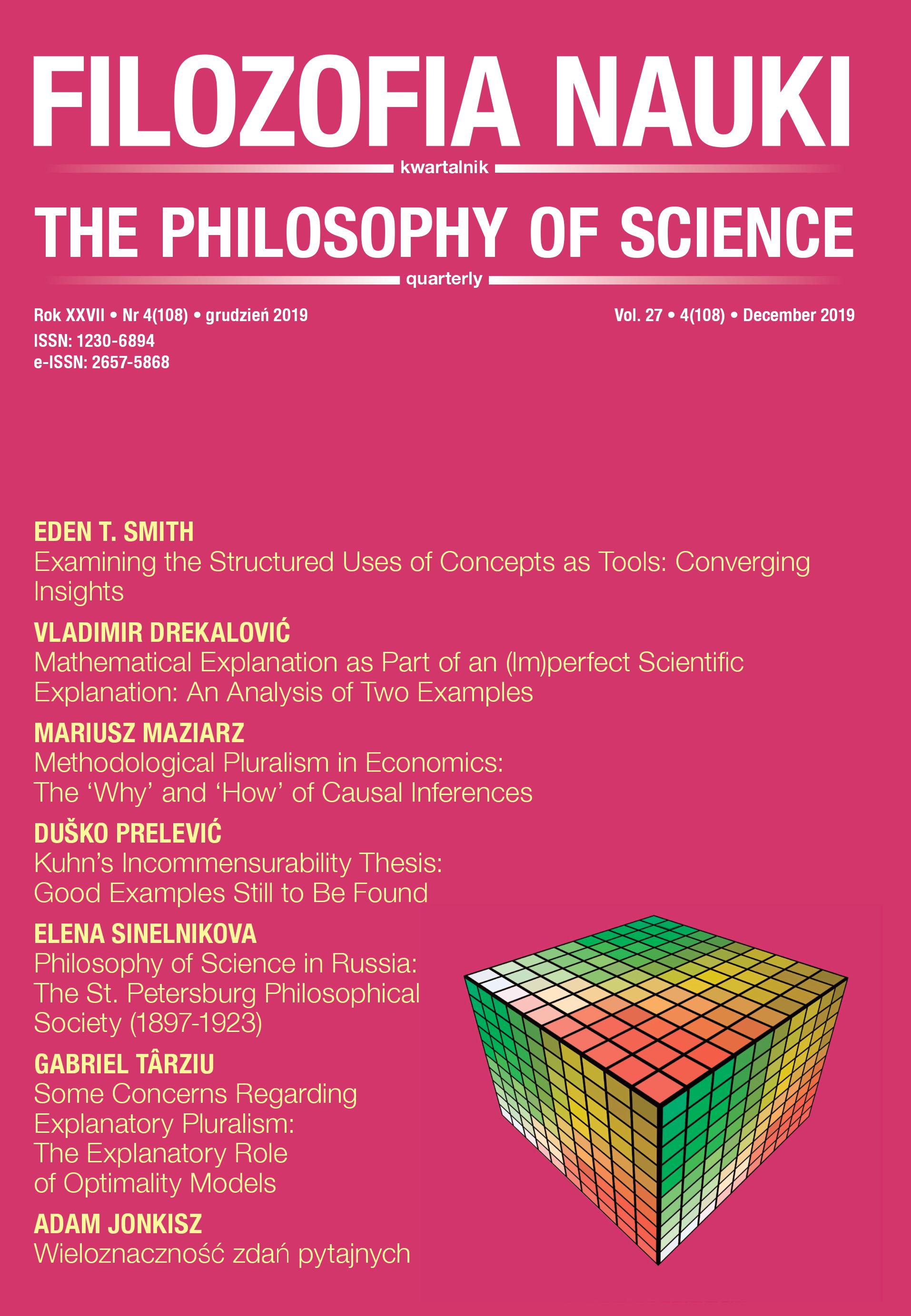Examining the Structured Uses of Concepts as Tools: Converging Insights.
DOI:
https://doi.org/10.14394/filnau.2019.0023Słowa kluczowe:
praktyka eksperymentalna, neuronauka, filozofia praktyki naukowej, historia nauki, filozofia naukiAbstrakt
Examining the historical development of scientific concepts is important for understanding the structured routines within which these concepts are currently used as goal-directed tools in experiments. To illustrate this, I outline how the concepts of mental imagery and hallucinations each draw on an older interdependent set of associations that, although nominally discarded, continues to structure their current independent uses for pursuing discrete experimental goals. In doing so, I highlight how three strands of literature offer mutually instructive insights into how the uses of current scientific concepts contribute to experimental practices. The first strand of literature includes recent scholarship examining how the uses of scientific concepts can enable scientific practices (e.g., Boon 2012, Brigandt 2012, Feest 2010, Steinle 2012), the second strand comes from the technoscientific studies focused on non-human agency (Pickering 1995), and the third draws attention to how the functions of concepts are grounded by the set of historically contingent experimental practices (e.g., Canguilhem 2008, Tiles 1984).
Bibliografia
Arabatzis T. (2012), “Experimentation and the Meaning of Scientific Concepts” [in:] Scientific Concepts and Investigative Practice, U. Feest, F. Steinle (eds.), Berlin: De Gruyter, 149-166.
Arabatzis T., Nersessian N. J. (2015), “Concepts Out of Theoretical Contexts” [in:] Relocating the History of Science, T. Arabatzis, J. Renn, A. Simões (eds.), Cham: Springer, 225-238. https://doi.org/10.1007/978-3-319-14553-2_15
Badcock J. C., Hugdahl K. (2012), “Examining the Continuum Model of Auditory Hallucinations: A Review of Cognitive Mechanisms” [in:] Hallucinations: Research and Practice, J. D. Blom, I. E. C. Sommer (eds.), New York: Springer, 317-328. https://doi.org/10.1007/978-1-4614-0959-5_23EDEN T. SMITH 20
Bloch C. L. (2012a), “Early Concepts in Investigative Practice the Case of the Virus” [in:] Scientific Concepts and Investigative Practice, U. Feest, F. Steinle (eds.), Berlin: De Gruyter, 191-218.
Bloch C. L. (2012b), Scientific Kinds without Essences [in:] Properties, Powers, and Structures: Issues in the Metaphysics of Realism, A. Bird, B. D. Ellis, H. Sankey (eds.), New York: Routledge, 233-256.
Bloch-Mullins C. L. (2015), “Foundational Questions about Concepts: Context-Sensitivity and Embodiment,” Philosophy Compass 10(12), 940-952. https://doi.org/10.1111/phc3.12272
Boon M. (2012), “Scientific Concepts in the Engineering Sciences: Epistemic Tools for Creating and Intervening with Phenomena” [in:] Scientific Concepts and Investigative Practice, U. Feest, F. Steinle (eds.), Berlin: De Gruyter, 219-244.
Brigandt I. (2010), “The Epistemic Goal of a Concept: Accounting for the Rationality of Semantic Change and Variation,” Synthese 177(1), 19-40. https://doi.org/10.1007/s11229-009-9623-8
Brigandt I. (2012), “The Dynamics of Scientific Concepts” [in:] Scientific Concepts and Investigative Practice, U. Feest, F. Steinle (eds.), Berlin: De Gruyter, 75-103.
Canguilhem G. (2008), Knowledge of Life, P. Marrati, T. Meyers (eds.), trans. S. Geroulanos, D. Ginsburg, 1st ed., New York: Fordham University Press.
Chang H. (2014), “Epistemic Activities and Systems of Practice: Units of Analysis in Philosophy of Science after the Practice Turn” [in:] Science after the Practice Turn in the Philosophy, History, and Social Studies of Science, L. Soler, S. Zwart, M. Lynch, V. Israel-Jost (eds.), Hoboken: Taylor and Francis, 67-79.
Diederen K. M. J., Neggers S. F. W., Daalman K., Blom J. D., Goekoop R., Kahn R. S., Sommer I. E. C. (2010), “Deactivation of the Parahippocampal Gyrus Preceding Auditory Hallucinations in Schizophrenia,” American Journal of Psychiatry 167(4), 427-435. https://doi.org/10.1176/appi.ajp.2009.09040456
Feest U. (2010), “Concepts as Tools in the Experimental Generation of Knowledge in Cognitive Neuropsychology,” Spontaneous Generations: A Journal for the History and Philosophy of Science 4(1), 173-190. https://doi.org/10.4245/sponge.v4i1.11938
Feest U. (2012), “Exploratory Experiments, Concept Formation, and Theory Construction in Psychology” [in:] Scientific Concepts and Investigative Practice, U. Feest, F. Steinle (eds.), Berlin: De Gruyter, 167-190.
Grossberg S. (2002), “Neural Substrates of Visual Percepts, Imagery, and Hallucinations,” Behavioral and Brain Sciences 25(2), 194-195. https://doi.org/10.1017/S0140525X02350040
Gutting G. (1989), Michel Foucault’s Archaeology of Scientific Reason, Cambridge—New York: Cambridge University Press.
Haraway D. (2006), “Crittercam: Compounding Eyes in NatureCultures” [in:] Postphenomenology: A Critical Companion to Ihde, E. Selinger (ed.), Albany: State University of New York Press, 175-188.
Hill K., Linden D. E. J. (2013), “Hallucinatory Experiences in Non-clinical Populations” [in:] The Neuroscience of Hallucinations, R. Jardri, A. Cachia, P. Thomas, D. Pins (eds.), New York: Springer, 21-42. https://doi.org/10.1007/978-1-4614-4121-2_2
Hoffman R. E., Hampson M., Wu K., Anderson A. W., Gore J. C., Buchanan R. J., …, Krystal J. H. (2007), “Probing the Pathophysiology of Auditory/Verbal Hallucinations by Combining Functional Magnetic Resonance Imaging and Transcranial Magnetic Stimulation,” Cerebral Cortex 17(11), 2733-2743. https://doi.org/10.1093/cercor/bhl183
Ihde D. (2009), Postphenomenology and Technoscience: The Peking University Lectures, Albany: SUNY Press.
Kindi V. (2012), “Concept as Vessel and Concept as Use” [in:] Scientific Concepts and Investigative Practice, U. Feest, F. Steinle (eds.), Berlin: De Gruyter, 23-46.
Latour B. (2005), Reassembling the Social: An Introduction to Actor-Network-Theory, Chicago: University of Chicago Press.
Law J., Mol A. (2008), “The Actor Enacted: Cumbria Sheep in 2001” [in:] Material Agency: Towards a Non-anthropocentric Approach, C. Knappett, L. Malafouris (eds.), New York—London: Springer, 55-57. https://doi.org/10.1007/978-0-387-74711-8_4
Machery E. (2007), “100 Years of Psychology of Concepts: The Theoretical Notion of Concept and its Operationalization,” Studies in History and Philosophy of Science. Part C: Studies in History and Philosophy of Biological and Biomedical Sciences 38(1), 63-84. https://doi.org/10.1016/j.shpsc.2006.12.005
MacLeod M. (2012), “Rethinking Scientific Concepts for Research Contexts: The Case of the Classical Gene” [in:] Scientific Concepts and Investigative Practice, U. Feest, F. Steinle (eds.), Berlin: De Gruyter, 47-74.
Nersessian N. J. (2012), “Modeling Practices in Conceptual Innovation: An Ethnographic Study of a Neural Engineering Research Laboratory” [in:] Scientific Concepts and Investigative Practice, U. Feest, F. Steinle (eds.), Berlin: De Gruyter, 245-270.
Pickering A. (1995), The Mangle of Practice: Time, Agency, and Science, Chicago: University of Chicago Press.
Pickering A. (2006), “Concepts and the Mangle of Practice: Constructing Quaternions” [in:] 18 Unconventional Essays on the Nature of Mathematics, R. Hersh (ed.), New York: Springer, 250-288. https://doi.org/10.1007/0-387-29831-2_15
Pickering A. (2012), “The Robustness of Science and the Dance of Agency” [in:] Characterizing the Robustness of Science After the Practice Turn in Philosophy of Science, L. Soler, E. Trizio, T. Nickles, W. Wimsatt (eds.), Dordrecht: Springer, 17-327. 2759-5_13
Pickering A. (2015), “Science, Contingency, and Ontology” [in:] Science as It Could Have Been, L. Soler, E. Trizio, A. Pickering (eds.), Pittsburgh: University of Pittsburgh Press, 117-128.
Pickering A., Stephanides A. (1992), “Constructing Quaternions: On the Analysis of Conceptual Practice” [in:] Science as Practice and Culture, A. Pickering (ed.), Chicago: University of Chicago Press, 139-167.
Rheinberger H.-J. (2009), “On the Historicity of Scientific Knowledge: Ludwik Fleck, Gaston Bachelard, Edmund Husserl” [in:] Science and the Life-World: Essays on Husserl’s Crisis of European Sciences, D. J. Hyder, H.-J. Rheinberger (eds.), Stanford, CA: Stanford University Press.
Rheinberger H.-J. (2010), An Epistemology of the Concrete: Twentieth-Century Histories of Life, Durham, NC: Duke University Press.
Robins R. (2008), “Inventing Oncomice: Making Natural Animal, Research Tool, and Invention Cohere,” Genomics, Society, and Policy 4(2), 21-35. https://doi.org/10.1186/1746-5354-4-2-21
Rudner M., Rönnberg J., Hugdahl K. (2005), “Reversing Spoken Items — Mind Twisting not Tongue Twisting,” Brain and Language 92, 78-90. https://doi.org/10.1016/j.bandl.2004.05.010
Schmidgen H. (2014), “The Life of Concepts: Georges Canguilhem and the History of Science,” History and Philosophy of the Life Sciences 36(2), 232-253. https://doi.org/10.1007/ s40656-014-0030-1
Shine J. M., Keogh R., O’Callaghan C., Muller A. J., Lewis S. J. G., Pearson J. (2015), “Imagine That: Elevated Sensory Strength of Mental Imagery in Individuals with Parkinson’s Disease and Visual Hallucinations,” Proceedings of the Royal Society B: Biological Sciences 282(1798), 2014-2047. https://doi.org/10.1098/rspb.2014.2047
Smith E. T. (2018a), The Structured Uses of Concepts as Tools: Comparing FMRI Experiments That Investigate Either Mental Imagery or Hallucinations, doctoral thesis, School of Historical and Philosophical Studies, Melbourne: University of Melbourne. MINERVA. http://hdl.handle.net/11343/219955
Smith E. T. (2018b), “Interdependent Concepts and Their Independent Uses: Mental Imagery and Hallucinations,” Perspectives on Science 26(3), 360-399. https://doi.org/10.1162/posc_a_00278
Steinle F. (2010), “Scientific Facts and Empirical Concepts: The Case of Electricity” [in:] Science as Cultural Practice, M. Epple, C. Zittel (eds.), Berlin: Akademie Verlag, 32-43.
Steinle F. (2012), “Goals and Fates of Concepts: The Case of Magnetic Poles” [in:] Scientific Concepts and Investigative Practice, U. Feest, F. Steinle (eds.), Berlin: De Gruyter, 105-126.
Steinle F. (2016), Exploratory Experiments: Ampere, Faraday, and the Origins of Electrodynamics, trans. A. Levine, Pittsburgh: University of Pittsburgh Press.
Tiles M. (1984), Bachelard, Science, and Objectivity, Cambridge: Cambridge University Press.
Waters C. K. (2014), “Shifting Attention from Theory to Practice in Philosophy of Biology” [in:] New Directions in the Philosophy of Science, M. C. Galavotti, D. Dieks, W. J. Gonzalez, S. Hartmann, T. Uebel, M. Weber (eds.), Cham: Springer, 121-139. https://doi.org/10.1007/978-3-319-04382-1_9



















 Filozofia Nauki | ISSN 1230-6894 | e-ISSN 2657-5868
Filozofia Nauki | ISSN 1230-6894 | e-ISSN 2657-5868